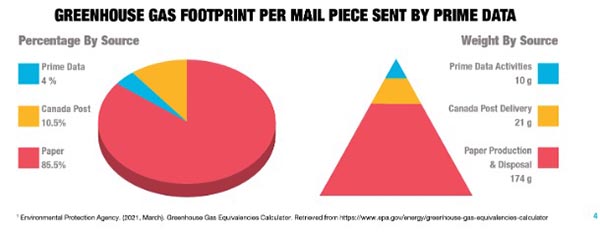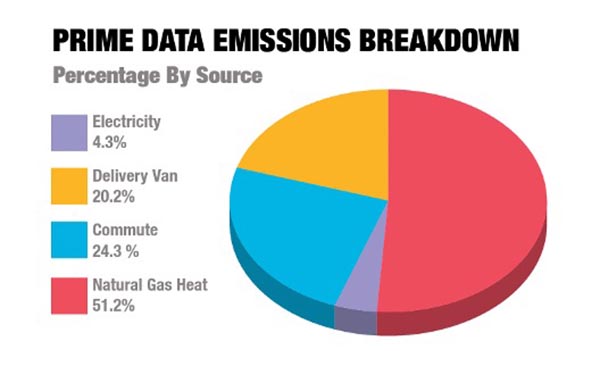(Last week, Heidi Tolliver-Walker looked at Prime Data’s efforts to calculate the carbon footprint of direct mail. In this follow-up, read about how Prime Data owner Steve Falk is using the data he gleaned to reduce his overall carbon emissions.)
Is it possible to have carbon-neutral direct mail? To Steve Falk, president of Prime Data, the answer is yes. Not only does he claim Canada-based Prime Data to be the first carbon-neutral direct mail house in the world, but he is so committed to long-term sustainability that he wants to open his process to enable other printers to do the same.
The project started when Falk, whose company puts millions of direct mail pieces into the mail stream every year, decided to determine the impact of his company on Canada’s emissions and Canada’s direct mail industry, specifically. “I wanted to do this for myself,” he says, “but I have also been seeing more and more industries, big banks, investors, and other stakeholders starting to ask the question: ‘What is the environmental impact of your business?’ Until we did the research, I didn’t have an answer.”
To find out, Falk engaged Luke Battcock, a researcher specializing in carbon footprint analysis. Battcock was tasked with determining the carbon footprint of Canada’s direct mail industry overall and Prime Data’s role in it. With the results in, Falk could begin taking steps to reduce that footprint, starting with the highest impact areas.
The ultimate result of this process is a net zero-emissions company and a new product, Carbon Neutral Direct Mail. With carbon-neutral mail, Prime Data offsets all of its greenhouse gas (GHG) emissions from the tree through to the mailbox. “Now, for the first time,” Falk says, “a direct mail piece can be produced and mailed with a net-zero carbon impact.”
Falk discusses the process in his webinar “Carbon Neutral Direct Mail Now!” in which he invites members of the industry to download Prime Data’s carbon footprint report, review the methodology, and use the tools to come up with their own carbon footprints. As an encouragement, he opens the webinar with the following statement: “It’s not as hard as you think. It’s not as complicated as you think. It’s a lot simpler than you imagine.”
The Origins of Carbon-Neutral Direct Mail
Overall, Canada generates 738 megatons (738 million tons) of GHGs each year. To determine what percentage of this comes from direct mail, Battcock broke down the direct mail journey into the following sectors:
- Forestry
- Paper production
- Employee commute
- Printing
- Distribution
- End-of-life processing
Using data from the Canada Post, the Canadian forestry and paper industries, and other sources (including the Environmental Paper Network calculator), Battcock determined the overall carbon footprint of Canada’s direct mail industry to be 492,000 tons, or 1/1500 of that of Canada’s carbon footprint overall. Next, Battcock looked at the carbon footprint of a piece of direct mail produced by Prime Data and how the company could it reduce that number.
Battcock broke Prime Data’s footprint down into three categories: paper, Canada Post, and Prime Data’s own internal operations. Put together, Battcock estimates that, in 2019 (the year the data was collected), the total carbon emissions of a direct mail piece sent by Prime Data—from tree to recycling or disposal—was 205g per piece. This includes the emissions generated from forestry, paper production, employee commutes, printing, distribution, and end-of-life processing. For comparison, that is the equivalent of driving about 830m in an average passenger vehicle or charging a smartphone 25 times.
Estimates specific to the paper and production practices at Prime Data alone (as opposed to the entire lifecycle of the mail piece) are 10g per piece.
Naming the Biggest Contributors

Where are those emissions coming from? Battcock determined that the primary contributor to the carbon footprint of a piece of direct mail is paper—85.5% of the total. This might be a surprise to some, especially since the paper industry is known for using renewable energy in its manufacturing processes. So where are these emissions coming from? Largely from the harvesting and transporting of the fiber and the finished paper.
“The paper industry is very good at tracking its own emissions, so when we started asking questions, we found a variation in 20–35% in emissions from mill to mill,” says Falk. “Those variations occur in the energy they use, as well as how they handle their trucking.”
The second largest contributor to Prime Data’s emissions is delivery of mail through Canada Post. This is primarily attributed to transportation, since the trucks used to move mail around are nearly all designed to use GHG-emitting fuels.

The last sector contributing to Prime Data’s direct mail carbon footprint is its own internal operations. For Falk, one of the big surprises of the study was that that this was actually the smallest component, only 4% of the total. These emissions came from three primary sources:
- Employee commutes (what vehicle do they drive and how far do they drive it?).
- Energy use (how much gas and electricity does Prime Data use?)
- Trucking back and forth between facilities.
Of these three, Battcock found, the largest contributor is energy. Of that energy, the emissions come primarily from the energy used for heating and cooling.
What Prime Data Is Doing About It
Once Prime Date knew its impact, it could begin strategically reducing that impact by starting with the highest impact areas. Since paper is the highest percentage of its carbon footprint, Falk started there.
- Prime Data is asking more questions of its paper suppliers and taking into consideration a paper’s carbon footprint as part of its vendor selection process. Vendors with lower carbon footprints are prioritized.
- Moving paper from place to place requires fossil fuels, so Prime Data is encouraging its trucking company to invest in electric vehicles. (It does not have its own fleet.)
- Moving heavy things takes more energy than moving lighter things, so Prime Data is working to reduce the weight of its mail. One of the ways it is doing this is by introducing the EZ Donor Mailer, which eliminates the outer envelope.
- In terms of its own company operations, Prime Data determined that it had a huge heating-cooling loss around its dock areas during loading and unloading, so it added heavy-duty energy curtains to minimize as much heating and cooling loss as possible.
- Prime Data is reducing the carbon footprint of its employee commutes by encouraging remote and hybrid work where applicable.
- Any emissions the company has not been able to eliminate are now being offsetting through the Great Bear Rainforest Carbon Offset project in British Columbia, Canada.
Prime Data is incredibly proud of its achievement and is now putting its carbon footprint analysis and its net zero carbon emissions status in its quotes and estimates.
Even as Prime Data works to reduce its own carbon emissions, it is opening its process and encouraging others to take advantage of what it has learned. After all, the fastest way to make a real dent in the industry’s carbon footprint is to work together. “How do we outsize our impact?” Falk concludes. “Through partnerships, webinars, and things like this to encourage everyone to work toward the same goal.”
More access to Prime Data’s carbon emissions report and methodology, click here.










Discussion
Join the discussion Sign In or Become a Member, doing so is simple and free